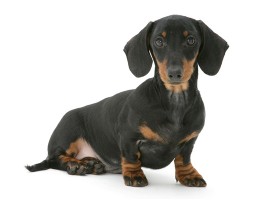The Dapple Dachshund is an intimidating breed recognized for its unique and visually appealing coat designs. The dapple design features bright spots or patches against a darker background, creating an attractive yet formidable look. The spots appear in different colors, such as chocolate, tan, black, cream, silver, blue, and red. Nonetheless, their charming, compact size is another standout trait.
This breed is more than just its attractive coat. Dapple Dachshunds are intelligent, loving, and faithful. Their fun-loving nature and small stature make them perfect friends for both individuals and families. These miniature dachshunds have lengthy bodies and stubby legs and are very energetic. Their compact size makes them ideal companions for individuals residing in apartment settings.
If you want a unique and affectionate friend with a fun, relaxed, and lovable personality, the Dapple Dachshund could be the perfect fit for you! Their quick learning ability is accompanied by their playful spirit, which guarantees endless amusement. Also, here are 19 reasons why a dachshund might be the worst breed for you and you should opt for another breed. These charming dogs can bring happiness and fellowship into your life for many years by giving them the necessary care and attention.
Dachshunds with Dapples: A Look Back
The intriguing Dapple Dachshund is a distinctive version of the well-loved breed, recognized for its enchanting, colorful coat. Originally bred in 16th-century Germany, this type was designed to hunt badgers. The German name for them, “Dachshund,” means “badger dog,” which shows their initial function.
These brave dogs were purposely bred for their role. They feature elongated, compact bodies with strong, short legs ideal for burrowing into badger burrows. Their sharp odor perception passed down from their hound dog predecessors, aided them in finding their target, while their cleverness and courage enabled them to battle on their own.
Dachshunds debuted in America during the 1880s, mainly in the Midwest and East Coast. They became trendy but dropped during World War I because of anti-German feelings. Nevertheless, their captivating appeal eventually turned things around, leading to their continued popularity as a breed.
The unique dapple design, with light markings on a dark coat, was officially recognized as a Dachshund coat variation by the American Kennel Club (AKC) in 1885. While the specific origin of the dapple gene remains a mystery, the first representation of a dapple Dachshund was observed in 1836.
While these dogs are adored for their eye-catching look, it is crucial to emphasize responsible breeding practices, especially for double-dapple Dachshunds. Breeding two dapple doxies together can significantly elevate the likelihood of health problems for the offspring.
A Canvas of Colors: The Dapple Dachshund’s Appearances
The Dapple Dachshund is a slightly upgraded version of the standard breed known for its unique coat pattern. Each Dapple puppy is different, with a mix of colors and shapes in their coat. The dapple pattern results from the merle gene, which creates lighter markings against a darker base coat color.
A dog receives two versions of each gene, one from its mother and one from its father. The merle gene, referred to as the dapple gene in dachshunds, is semi-dominant, meaning a dog requires only one copy to exhibit a merle coat.
These markings may present as dots or bursts of color. Transforming their coats into pieces of abstract art you can wear. The dapple gene is a genetic change affecting pigment distribution in a dog’s fur. Dapple Dachshunds come in various colors: black, tan, cream, chocolate, blue, silver, red, and piebald. These dogs might have blue eyes, brown eyes, or maybe one blue and one brown eye.
The single dapple is the most common type of Dapple Dachshund, having one copy of the Merle gene. However, double-dapple Dachshunds also carry two copies of the Merle gene. To produce a double dapple dachshund, each parent should possess Mm alleles and transfer their dominant genes (MM) to their offspring. These double dapples often display a more distinct dappling pattern, but they also come with a heightened risk of health problems like deafness and blindness.
Along with their distinctive coat patterns, Dapple Dachshunds possess the same physical traits as others. They possess elongated, low bodies accompanied by short, strong legs. Their heads are elongated and slender, featuring a subtly arched cranium. They have long, drooping ears and an extended, pointed tail. Standard Dapple Dachshunds typically weigh between 16 and 32 pounds, while miniature Dapple Dachshunds weigh 11 pounds or less.
The Dapple Dachshund’s Personality
Dachshunds are known for their prominent characters. Dapple dachshunds possess even more vibrant personalities than their standard dachshund relatives. These dogs might be petite but exude considerable confidence and a hint of sass. They are clever, energetic, and brave, frequently characterized as possessing the spirit of a lion in a compact, sausage-like frame.
Originally developed for hunting, dapple dachshunds have a strong instinct to chase prey and can be rather obstinate, which makes training difficult. They demonstrate independent thinking and frequently challenge limits, necessitating a patient and persistent owner in setting clear rules and boundaries. However, make sure to mistake their obstinacy for a deficiency in intelligence. Dapple dachshunds are clever canines that can learn various tricks and commands when provided with suitable incentives, typically using delicious rewards.
Although they have an independent temperament, dapple dachshunds are incredibly loving and devoted to their owners. They enjoy snuggling and seeking affection, frequently trailing their favorite person throughout the home. Nonetheless, their affection for their family can occasionally show up as jealousy when they sense their unique connection is at risk. These dogs are recognized for being talkative and readily barking at unfamiliar individuals or anything they consider dangerous.
Although their lively nature may be amusing, prospective owners must be ready for the dedication needed to train and socialize a dapple dachshund. Prompt and regular training is essential to handle their stubbornness and guarantee they develop into well-adjusted friends. These tiny powerhouses can provide their families with years of happiness and laughter with the proper method.
A Dappled Coat, A Fragile Frame: Health Quirks of the Dapple Doxies
Dapple Dachshunds are certainly charming with their distinctive, spotted fur. However, their attention-grabbing appearances require recognizing the possible health hazards linked to their vivid design. Like fragile artwork that requires meticulous upkeep, these spotted puppies demand additional care and focus to flourish.
One of the biggest concerns is Double Dapple Syndrome, which can occur when two dapple Dachshunds are bred together. This is a genetic lottery you don’t want your pup to play. The double dose of the Merle gene responsible for the dappling can lead to many problems, from vision and hearing impairments to missing or “micro eyes.” Think of it as cranking up the volume on the dapple gene – the pattern might be intensified, but the potential for health complications also gets amplified.
Ethical breeders know this and avoid breeding two dapples together. They realize that a healthy dog matters more than having an impressive look. Choosing a reputable breeder that emphasizes genetic testing can help give your dapple companion a more significant opportunity for a long and healthy life.
However, even single-dapple Dachshunds can be prone to specific health issues. They share the same vulnerabilities as their solid-colored counterparts, with their unique body shape playing a pivotal role. Their elongated spines, which contribute to their adorable “sausage dog” look, make them particularly susceptible to Intervertebral Disc Disease (IVDD). This troubling condition affects the discs that safeguard the vertebrae in the spine and, in severe cases, can lead to paralysis.
Here are some other health conditions that can affect Dapple Dachshunds:
- Eye problems include cataracts, progressive retinal atrophy (a degenerative eye disease), and glaucoma. Just like the dapple pattern can disrupt pigmentation in their fur, it can also affect their eyes, making them more vulnerable to these issues.
- Ear problems: Deafness is another concern, especially with double dapples.
- Skin cancer: Due to reduced pigmentation, dapple Dachshunds may be more susceptible to sunburn and skin cancer.
- Obesity: Their love for treats and their short legs can make weight management tricky. Excess weight puts additional strain on their already vulnerable backs, increasing the risk of IVDD and other joint problems.
- Bloat: This is a life-threatening condition that affects deep-chested dogs.
- Epilepsy: Dapple Dachshunds can also be prone to seizures.
Before you start to worry too much, keep in mind that not every dapple Dachshund will face these health issues. Numerous individuals enjoy lengthy, healthy lives through appropriate treatment. However, recognizing these possible problems can assist you in becoming a more knowledgeable and proactive owner.
Routine veterinary examinations, a well-balanced diet, managed portion sizes, suitable exercise (consider fun walks and playtime rather than jumping contests), and plenty of affection are the ideal formula for content and healthy dapple Dachshund. By being aware of their specific needs and susceptibilities, you can assist your speckled companion in having a long and rewarding life filled with tail wags and adventures.
Taming the Tiny Tornado: A Guide to Dapple Dachshund Care and Training
Having a dapple dachshund is akin to having a small, four-legged jester in your house. Their playful behaviors, lively characters, and distinct fur patterns add happiness and amusement to every home. However, these tiny powerhouses are also recognized for their obstinate nature and fragile bodies, which need a unique combination of attention and training to help them flourish.
-
The Backbone of Health: Protecting the Precious Spine
A key element of caring for dapple dachshunds is safeguarding their delicate spines. Their long backs, though cute, make them susceptible to Intervertebral Disc Disease (IVDD). This condition may lead to pain, difficulties in movement, and potentially paralysis. So, how can you maintain your little sausage dog’s back in excellent condition?
No Jumping Olympics: Discourage jumping from heights, whether off the furniture, down the stairs, or into your arms. Invest in ramps or steps to help them navigate different levels without straining their backs.
Weight Watchers Club: Keep those chubby rolls in check! Obesity puts extra pressure on their spines. Feed them a balanced diet, measure their food portions carefully, and resist those puppy-dog eyes begging for additional treats. Regular exercise also helps maintain a healthy weight.
-
The Dapple Dilemma: Breeding for Health, Not Just Looks
The dapple pattern is undoubtedly delightful, yet it’s essential to recognize the possible health issues linked to the merle gene. When two dapple dachshunds’ mate, their puppies face an increased risk of Double Dapple Syndrome. This may result in significant problems such as vision and hearing loss, absent eyes, or “micro eyes.”
Ethical Breeding is Key: Choose a reputable breeder who prioritizes genetic testing and avoids breeding two dapples together. Ask about the parent’s health history and look for signs of responsible breeding practices.
-
Grooming the Dapple Dandy: From Smooth to Wirehaired
Dapple dachshunds are available in three coat types: smooth, wirehaired, and longhaired. Every type has distinct grooming requirements.
Smooth Operators: Smooth fur is the simplest to care for, requiring occasional brushing and bathing.
Longhaired Beauties: Coats with long hair require more regular brushing to avoid mats and tangles.
Wirehaired Marvels: Wirehaired coats require consistent hand-stripping and weekly brushing to preserve their texture.
-
Training the Stubborn Sausage: Patience is Your Superpower
Dapple dachshunds are intelligent but independent dogs, often described as stubborn. They were bred to hunt, so they have a mind of their own and a strong prey drive. Training them requires patience, consistency, and a positive approach.
Early Start: Begin training as early as possible.
Positive Reinforcement: Use rewards-based methods, such as treats and praise, to motivate them.
Short and Sweet: Keep training sessions brief and engaging to maintain their focus.
Socialization is Key: Expose them to different people, dogs, and environments to help them develop into well-rounded dogs.
-
Living with a Dapple Doxie: Embracing the Bark and the Snuggle
Dapple dachshunds are recognized for their vibrant personalities and their affection for attention. These dogs are noisy and tend to bark frequently. They likewise desire hugs and companionship.
Bark Control: Although you can’t entirely stop their barking, you can regulate it through training. Instruct them on a “quiet” command and ensure they receive ample exercise and mental engagement to avoid barking due to boredom.
Cuddle Time: Ensure that you surround them with love and focus. They flourish on affection and snuggles, making them excellent partners for those who appreciate a tight connection with their furry companions.
Remember that owning a dapple dachshund involves commitment. It consists in recognizing their unique traits and constraints while offering the guidance and assistance essential for a joyful and healthy existence. As a caring and dedicated pet owner, you can anticipate many years of devotion, joy, and unwavering affection from your small, spotted friend.
A Faithful Friend with Distinctive Appeal
The Dapple Dachshund merges a stunning appearance with a vibrant character. Although their care demands careful attention, the benefits of living with one of these playful, devoted dogs are genuinely priceless. Focusing on responsible breeding, regular healthcare, and ongoing training guarantees that your dapple Doxie flourishes as a valued part of your family.
With their unique coats and lively personalities, Dapple Dachshunds are more than mere pets—they’re vibrant, wagging masterpieces.

 DogExpress
DogExpress























 in Chandigarh, India.
in Chandigarh, India. 
